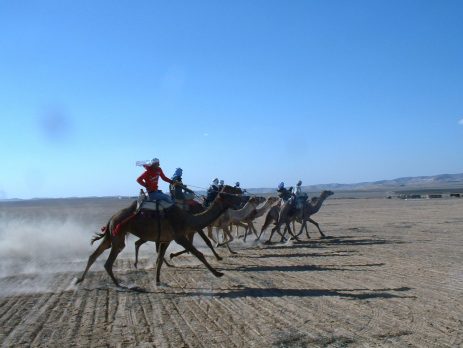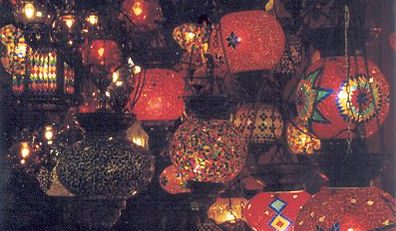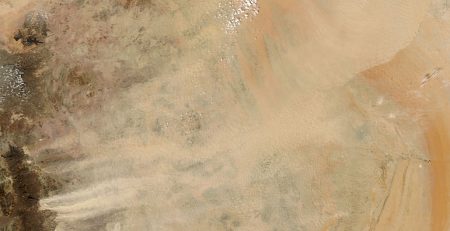Dispossession by Law: How the Israeli Judicial System Utilizes Ottoman Land Law to Expel and dispossess the Bedouins
by Ahmed Amara
On May 5, 2015, Israel’s Supreme Court rejected the Abu al-Kia’an family’s appeal against the decision of the government and the planning authorities to evict the inhabitants of two Bedouin villages that inhabit about 1,000 members of the family. In their stead and on the land that the family cultivates, the government will build a new settlement named Hiran and a new forest named Yatir. The state argued in court that the Bedouins were trespassers on state land and based on this fact it decided to establish a settlement and to authorize the eviction of the inhabitants against compensation. Several days later, on May 14, 2015, the Supreme Court ruled in the matter of the al-Uqbi family regarding land, part of which is in the area of al-Arakib, a village that has been destroyed by the state more than eighty times since 2010. The Supreme Court ruled, on the basis of Ottoman and British laws, that the land in question is “dead (mawat) land”, and thus state land.” “Dead land” is defined under Ottoman law as land that is not possessed or cultivated by anyone and that lies more than one and a half miles from an inhabited area. However, a historical review reveals that the court drew on such historical legal categories in a selective manner that rendered them meaningless.
The 1948 war had catastrophic consequences for the Arab Bedouins, only 13 percent of whom remained within the armistice boundaries of Israel and the remainder of whom became refugees in nearby states. Some 11,000 Bedouins remained in the Negev, comprising nineteen of the ninety tribes that had been in that area before the war. A decision on the fate of the Bedouins who remained in the Negev lay before the prime minister at the time, David Ben-Gurion, and other politicians and military figures, immediately after the combat in the Negev. Ben-Gurion initially wanted to expel the remaining Bedouins, but he changed his mind and weighed that idea against two additional proposals set before him: transferring the Bedouin to mixed Jewish-Arab cities in the center of the country or concentrating them in a defined area and then settling them in three towns. The latter of the two proposals was adopted, and in its wake the army started evicting, transferring, and concentrating the Bedouins. From 1949 until the mid-1950s, eleven Bedouin tribes were moved by force from the western Negev, to the “siyaj” (or sayag) area (fenced or closed region). There they joined eight other tribes that had lived originally within the siyaj. The boundaries of the siyaj area, which comprised about 8 percent of the Negev’s area, were determined by considerations of security and land control, its inhabitants were kept under Israeli military rule until 1966, and within it Bedouin towns were eventually established. The boundaries of the siyaj, even if they are not visible today, still exist and are in effect. An example of this is one of the sections of the Prawer Plan that was later amended, which forbade Bedouin settlement outside the siyaj. Also, most of those who laid claim to land within the siyaj received more favorable compensation offers than those who claimed land outside it.
The first years of the state shaped the human and legal geography of the Negev Bedouins: eviction, removal, transfer, and criminalization in relation to housing and land ownership or possession. The forms of eviction varied slightly from tribe to tribe, but in general they involved a combination of the use of force, threats of the use of force, and official government and military pronouncements and orders. Usually, the military commander of the Negev would issue an order, sign it in Arabic and Hebrew, and hand it to the sheikh of the tribe. The order stated that the tribe had to move from its place of residence for a temporary period of up to six months. Under government policy, or its lack thereof, the concentration of the Bedouin tribes in the siyaj area created a space that was constructed and characterized in later years by illegality. The tribes were resettled and worked the land they were ordered to settle on. The allocation of land was partly oral and informal and partly official, through a lease from the state. For example, until 1956, the state authorities transferred the al-Kia’an family by force four times until it was settled in Umm al-Hiran. There Uri Lubrani, then the prime minister’s adviser on Arab affairs, allocated to the whole family a total of 7,000 dunams of land. The al-Uqbi family suffered a similar fate. The land allocated to the evicted and transferred families belonged to other tribes in the Negev or to Bedouin refugees. Immediately after the evictions, the land that had been emptied or declared a closed military area was expropriated under the Abandoned Property Law or the Land Acquisition Law. Generally, this history is ignored by the court and excluded from the application of the formal law. In addition, there is a substantial body of legal history that is attached to the lands claimed by the Negev Bedouins, and is also usually ignored or misinterpreted.
In 1952, the Minister of Justice appointed a special committee to clarify the question of land ownership of the Negev Bedouins. Its three members were Yehosua Palmon, the prime minister’s adviser on Arab affairs; Binyamin Fishman, of the Department of Land Title Settlement, and Yosef Weitz, the representative of Keren Kayemet L’Yisrael (the Jewish National Fund). In a confidential report presented to the Minister of Justice, the committee concluded that “it is known for a fact that during the Mandate period, large tracts of land were registered under the names of the Bedouins, based on proof that these lands were cultivated by them throughout the period of qualifying land possession [10 years], and an important part of these lands were transferred [through sale], after being registered, to Keren Kayemet, to other Jewish companies, and to individual Jews. Thus, in this matter there are hundreds of precedents, and we are of the opinion that the government of Israel will not be able to, and should not, ignore them… After all, it is possible that the Bedouins have proof of possession of many other areas, such as receipts for tax payments of tithe that will serve as proof of cultivation of other large areas.” Therefore, “one should not refrain from recognizing the Bedouins’ rights to ownership of the areas that they prove they have cultivated for a long time (the period of limitation),” that is, a period of ten years as required by Ottoman and British law.
In these sentences the committee summarized important facts in the history of the Bedouins and their rights. Bedouins cultivated between 2 million and 3.5 million dunams in the area of Beersheba. They grew mainly barley, which was known for its quality, part of which was exported via Gaza for the beer industry in Scotland and Europe before World War One. Through agriculture and the payment of taxes, which were the main means of obtaining land rights, Bedouins obtained land rights, even if these were not registered formally. Bedouin agriculture, absurd as it may sound to some of us, did exist in the Negev in varying degrees for hundreds of years. For example, according to the American traveler William Thomson, who passed through Bedouin land in the Negev in 1857, “What sort of country have we before us to-day? Beautiful in itself, but monotonous- wheat, wheat, a very ocean of wheat.” Cultivation of the land was one of the main sources for obtaining ownership rights under Ottoman rule. The Ottoman and British administrations recognized the Bedouin ownership system and the internal registers of sheikhs who also served as tax collectors. In addition, there were Bedouins who registered their land in the land registry during the Ottoman period.
During the Mandate, too, land rights continued to be anchored in various forms both formal and informal. Moreover, when land was sold to Zionist bodies or individuals, the Bedouin owners would register the land under their own names, and only later would they transfer the rights to the purchasers. As long as those with rights to the land paid the taxes, they met the main demands and expectations of the Ottoman and British governments, which did not bother to establish a fully-furnished legal or administrative apparatus in the Beersheba district. The orderly registration of rights introduced by the British in 1928, known as the land title settlement process, did not reach the Negev until 1948. However, the British Mandatory government noted that when the arrangement of land rights eventually reach Beersheba, it was expected that some 2 million dunams would be considered as Bedouin-owned land. With the change in the political landscape in 1948, the ownership regime changed too, along with the region’s history.
In 1970 the Israeli government initiated a process of land title settlement among the Negev Bedouin, especially in the siyaj area. By 1979, Bedouins had submitted 3,220 land claims to a total of 1.5 million dunams, which included half a million dunams of pasture. Part of the land claimed was outside the siyaj and had already been expropriated and registered as state land. A committee appointed by the Israeli government in 1975, headed by Plia Albeck of the state attorney’s office, noted that the Bedouin-claimed land was 850,000 dunams and stated that the Bedouins had no legal rights to the land. Relying on British and Ottoman laws, Albeck determined that the land was “dead land,” that is, land that was far from habitation, that was neither possessed nor cultivated, and therefore belonged to the state. But because Albeck expected that the court would not allow eviction from the land without compensation, she recommended that the government freeze the land ownership claims and negotiate with the claimants.
The compensation formulas were complicated and varied from one claimant to another, but they combined a land plot for building in state-planned Bedouin towns, water for agriculture, and monetary compensation, amounting generally to about 10 percent of the claim. The government adopted the recommendations, froze the claims, and embarked in negotiations. From the start it was clear to the government that the Bedouins were not enthusiastic about the proposal, and so it was. By 2005 the government had resolved only 15 percent of the claims, most of them by force during the eviction from Tel el-Meleh to build the Nevatim airbase. Around 2005 the state began to submit counterclaims to the original claims of the Bedouins, and to this day it has won 100 percent of the cases, numbering hundreds, the latest of which is the al-Uqbi ruling. The adoption of Albeck’s recommendations and the counterclaims marked two important turning points in the history of the Negev and especially in relation to the government’s position and its delicate relations over the years with the Bedouins.
Israel’s frequent governments continue to endorse the Negev Bedouin land question without an appropriate solution in sight. Only after 2007, the Israeli government has appointed a number of committees (the Goldberg, Amidror, Prawer, and Begin committees). Meanwhile, the urbanization project has failed, tens of thousands of Bedouins live in distressed conditions in unrecognized villages, some 2,000 ownership claims continue to keep the authorities busy and lead to evictions and demolitions, but nothing is really resolved. What is clear is that there is no solution on the horizon or any intention of trying to reach a mutually acceptable agreement that could lead to new opportunities and a new life for the residents of the Negev.







Leave a Reply